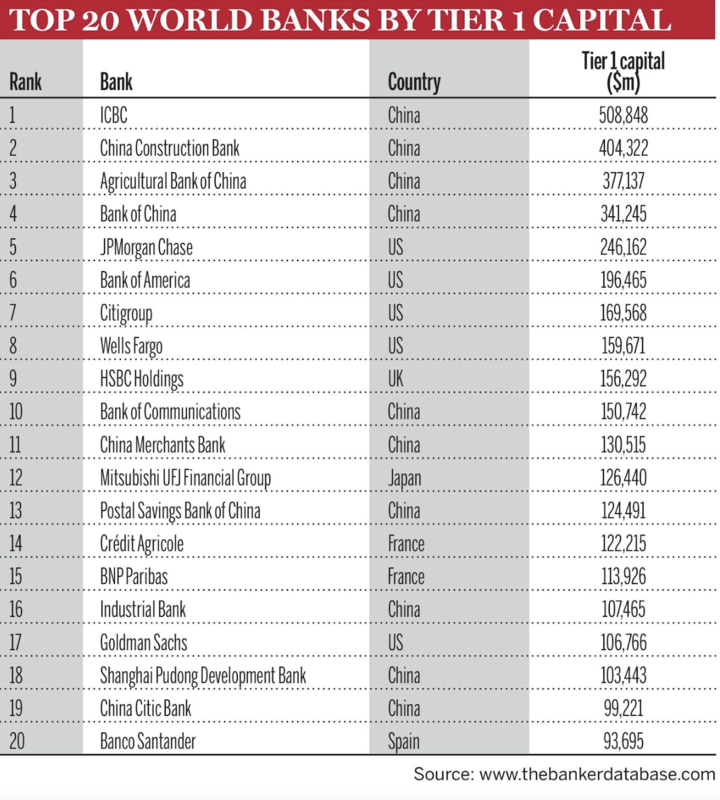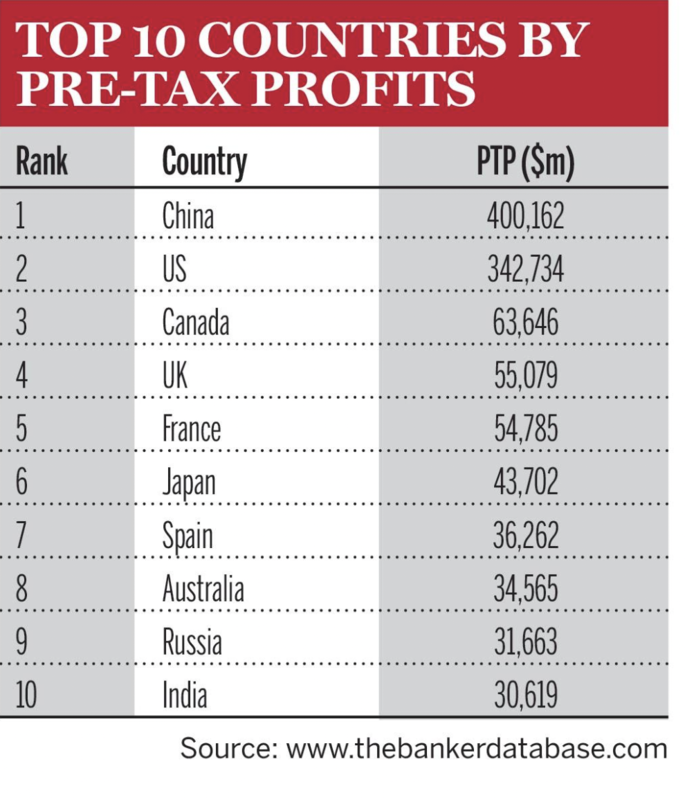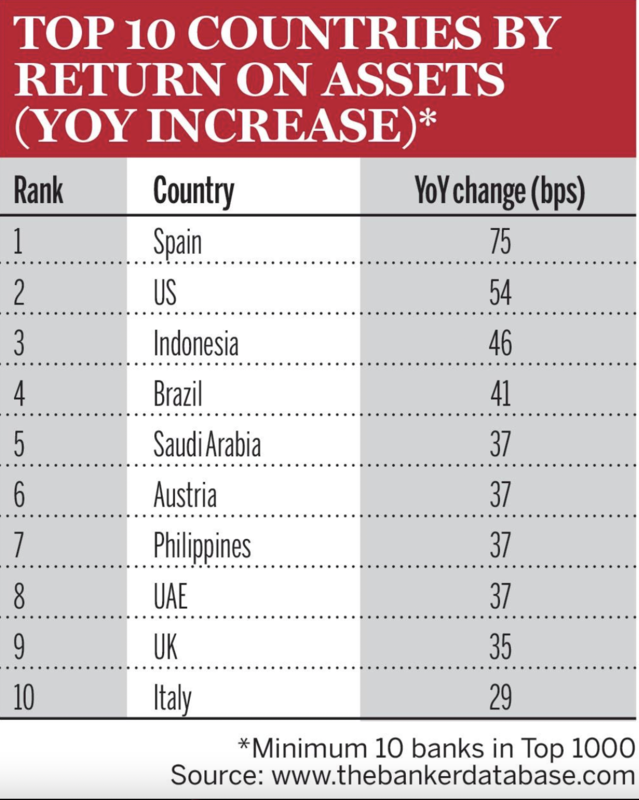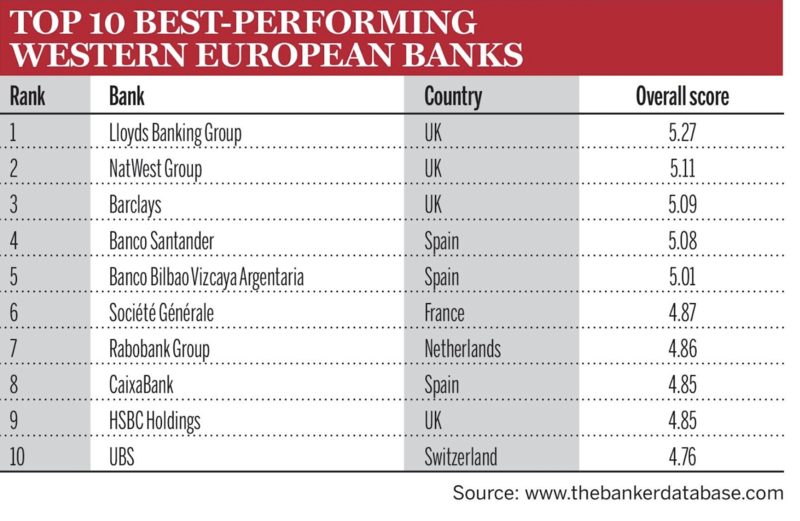4 July 2022: For the first time since 2015, the UK banks in The Banker’s Top 1000 World Banks ranking have generated more profits than their French counterparts. The UK recorded $55.1 billion in aggregate pre-tax profits in 2021, compared to $54.8 billion for France and $13.9 billion for Germany.
UK lenders also posted a higher aggregate return-on-assets (ROA) ratio (0.50%) than French banks (0.37%), German banks (0.23%) and the European average (0.44%).
In addition, the UK was one of only seven of the 22 western European countries in the ranking that logged an improvement in its aggregate Tier 1 capital position, albeit by 0.94%. Overall, western Europe was the only region to record a drop in Tier 1 capital (3.6%), a key measure of banking strength, as the sector continues to struggle after the global financial crisis in 2008/9.
HSBC remains the only European bank in the top 10 for the 11th year running and is now the only lender that is not Chinese or American, following Mitsubishi UFJ Financial Group’s drop to 12th position. HSBC fell one position to ninth, resulting from a 2.4% contraction in its Tier 1 capital, to $156.29 billion.
Of the other ‘big six’ UK banks, Barclays (global ranking: 24), Lloyds Banking Group (42), Standard Chartered (51) and Nationwide Building Society (106) saw increases in their Tier 1 capital, with Nationwide posting the largest rise (30.1%) and moving up 15 places in the Top 1000. Like HSBC, NatWest Group (53) reported a drop in Tier 1 in 2021. This pattern was repeated with total assets.
All six banks were profitable in 2021, with Lloyds Bank reporting the largest upsurge, of 470.6% and NatWest moving from loss to profit.
The Banker editor Joy Macknight said: “After taking a profitability hit in 2020, the UK banking sector has rebounded and recorded a more than 200% increase in pre-tax profits. However, much of the boost can be attributed to a reduction or reversal in last year’s credit impairment charges for expected loan losses that didn’t materialise, like most lenders across the world.”
When The Banker’s best-performing methodology, which looks at improved performance across eight metrics, is applied to the largest 20 western European banks, it is three UK lenders that come out on top. Lloyds Bank emerges as the best-performer lender of the cohort, surpassing its peers in return on risk, asset quality and growth, followed by NatWest and Barclays in second and third place, respectively.
Global results
Overall, the global banking system is better capitalised than ever before. The 1000 largest banks’ aggregate Tier 1 capital has surpassed $10 trillion for the first time in the history of The Banker’s Top 1000 World Banks ranking.
The total Tier 1 capital, which is a key measure of banking strength, has reached $10.38 trillion, an increase of 4.7% year on year. In addition, aggregate total assets have broken the $150 trillion barrier for the first time – at $154.21 trillion.
“The global banking industry is in a strong position to deal with the challenges emerging in 2022,” said Macknight. “The year has had a tumultuous start, with the war in Ukraine amplifying supply chain challenges and commodity volatility, as well as global inflationary pressures and the winding down of Covid-19 stimulus packages. However, the rising interest rate environment is expected to help banks’ margins and profitability.”
Chinese lenders continue to dominate at the top of the ranking. Industrial and Commercial Bank of China, China Construction Bank, Agricultural Bank of China and Bank of China held on to the top four spots for the fifth year in a row. With Bank of Communications edging into 10th position, Chinese banks now make up half of the top 10 for the first time.
TABLES:
|
|
|
|
|
|
|
|
Notes
Tier 1 capital is the core measure of a bank’s financial strength under the Basel regulatory framework.
Contact
For more information, please contact:
Henry Conner | henry.conner@edelmansmithfield.com | 07709 577073
Mark Staniland, senior communications manager, Financial Times | mark.staniland@ft.com
About The Banker
The Banker is the world’s premier banking and finance resource, providing global financial intelligence since 1926.
The Banker is the key source of data and analysis for the industry. The Banker’s Top 1000 World Banks ranking has been setting the industry benchmark since 1970, providing comprehensive intelligence about the health and wealth of the banking sector. To find out more visit www.thebanker.com/top1000.
Joy Macknight is the editor of The Banker. She joined the publication in 2015 as transaction banking and technology editor and was promoted to editor in March 2021. She has been a financial and technology journalist for more than 15 years.
About the Financial Times
The Financial Times is one of the world’s leading business news organisations, recognised internationally for its authority, integrity and accuracy. The FT has a record paying readership of 1.2 million, more than one million of which are digital subscriptions. It is part of Nikkei Inc., which provides a broad range of information, news and services for the global business community.










